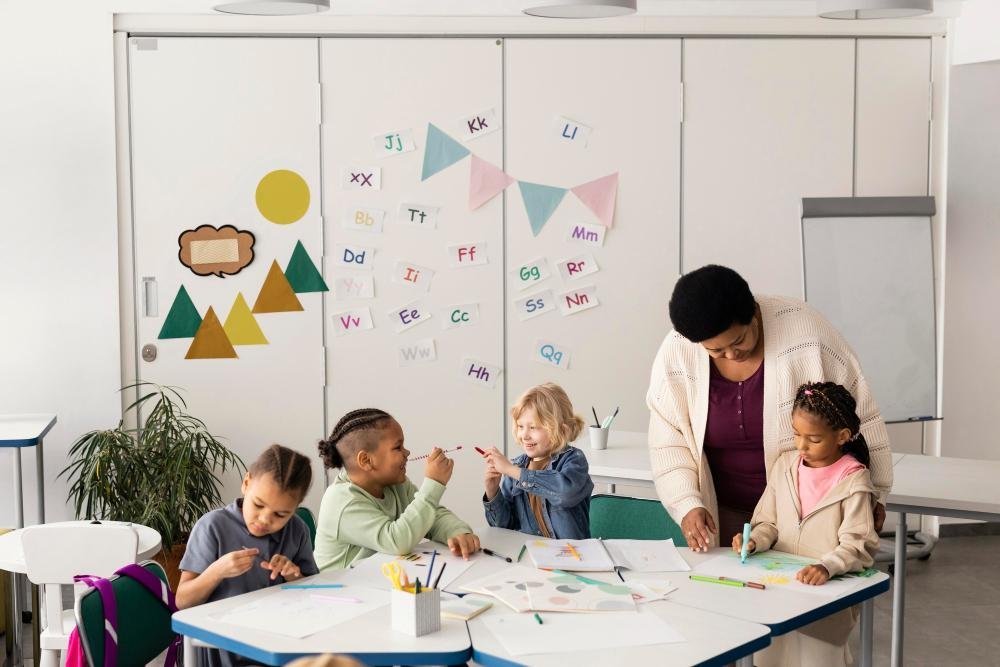How to Make a Lesson Note for Nursery Class – What is a Lesson Note?
How to Make a Lesson Note for Nursery Class is a challenge many teachers in the nursery section encounter almost every week. However, it is important we understand what a lesson note is all about. A lesson note is a structured document prepared by a teacher to outline the key aspects of a lesson, including objectives, teaching methods, instructional materials, activities, evaluation, and assignments. It serves as a guide for effective lesson delivery and ensures that learning objectives are met.
Importance of a Lesson Note to the Teacher
- Guides Lesson Delivery: A lesson note provides a structured plan, helping teachers stay on track and deliver lessons effectively.
- Ensures Curriculum Coverage: It aligns with the curriculum, ensuring that all essential topics are covered.
- Enhances Classroom Management: A well-structured lesson note helps maintain order by outlining step-by-step instructions and activities.
- Facilitates Student Engagement: Through planned interactive activities, teachers can actively engage students in learning.
- Aids in Lesson Review and Improvement: Teachers can evaluate and refine their lesson plans based on students’ performance and feedback.
READ ALSO: AI in Education: 7 Amazing & Simple Steps On How To Use AI To Write A Standard Teacher’s Weekly Lesson Note With Samples [AI in Education -The Future of Learning in 2025 and Beyond]
The Peculiarity of the Nursery Section in the School Setting
How to Make a Lesson Note for Nursery Class is essential because of the peculiarity of the nursery department Nursery classes form the foundation of formal education. At this stage, children between the ages of 3 and 5 are introduced to basic concepts in literacy, numeracy, and social skills. Their learning is largely play-based and requires a high level of creativity, patience, and engagement. Due to their short attention span, lessons must be interactive, fun, and structured with appropriate instructional materials.
Why a Well-Designed Lesson Note is Necessary
One of the reasons why you understand How to Make a Lesson Note for Nursery Class is for the fact that a well-designed nursery lesson note is as important as the lesson delivery itself. This is for the fact that:
- Nursery children learn through sensory experiences; therefore, a well-planned lesson note ensures that hands-on activities are included.
- It helps the teacher manage time efficiently and engage children effectively.
- A structured lesson note ensures that learning objectives are clear and achievable.
- It provides consistency in lesson delivery, which is crucial for young learners.
SEE ALSO: Bilateral Education Scholarship (BEA) 2025/2026: 5 Secrete Keys on How To Succeed For BEA Scholarship & Unlock Global Opportunities for Nigerian Students!
See How to Make a Lesson Note for Nursery Class – Step-by-Step Guide to Crafting a Perfect Lesson Note for Nursery Class
- Topic Selection
Choose a simple, age-appropriate topic. Example: Identifying Colors for Nursery 3.
- Specific Objectives
Clearly state what the children should achieve by the end of the lesson. Example:
- Pupils should be able to identify at least five different colors.
- Pupils should be able to differentiate between primary and secondary colors.
- Instructional Materials
Gather materials that will aid learning. Examples:
- Color charts
- Crayons and coloring books
- Flashcards
- Objects of different colors (e.g., red apple, blue ball)
- Instructional Techniques
Nursery classes require interactive teaching techniques such as:
- Demonstration: Showing objects of different colors.
- Storytelling: Using stories to introduce colors.
- Songs and Rhymes: Singing color-related songs.
- Play-based Learning: Engaging in hands-on coloring activities.
- Entry Behaviour
Assess prior knowledge by asking questions like:
- “Can you name some colors you know?”
- “What is your favorite color?”
- Set Induction
Introduce the lesson in a fun way. Example:
- Show a rainbow and ask children to name the colors they see.
- Play a color-matching game.
- Development of the Topic/Teacher’s Performance Activities
Step 1: Explanation
- Display a color chart and discuss the names of different colors.
- Explain the concept of primary colors (red, blue, and yellow) and how they form the basis for other colors.
- Introduce secondary colors (green, orange, and purple) and demonstrate how they are formed by mixing primary colors.
Step 2: Demonstration
- Hold up real-life objects corresponding to the colors discussed.
- Conduct a color-mixing activity using paints, asking pupils to predict the outcomes before mixing.
- Show flashcards with different color shades and ask pupils to name them.
Step 3: Group Activities
- Distribute crayons and let children color worksheets with outlined objects.
- Organize a “Color Hunt” where children find objects of specific colors around the classroom.
- Play a sorting game where children classify objects based on color.
- Introduce a simple memory game using colored cards to reinforce learning.
- Evaluation
Assess understanding through:
- Asking children to identify colors from a set of flashcards.
- Providing worksheets were children color specific items correctly.
- Asking pupils to match objects with corresponding color names.
- Summary and Closure
- Recap the lesson by revisiting key points, and emphasizing primary and secondary colors.
- Engage pupils in a short discussion where they talk about their favorite colors and describe related objects.
- Home Assignment
Give a simple take-home activity:
- “Find five objects of different colors in your home and tell your parents their names.”
- “Draw and color a picture using at least three different colors.”
CHECK OUT: WAEC 2025 Registration: Deadlines, Study Tips, Success Secrets from Top Scorers & 8 Easiest Steps For School Candidates, And Private Candidates Registrations
How to Make a Lesson Note for Nursery Class – Sample Lesson Note for Nursery 3
Topic: Identifying Colors
Class: Nursery 3
Duration: 30 minutes
Specific Objectives:
- Pupils should be able to identify five primary colors.
- Pupils should differentiate between primary and secondary colors.
- Pupils should engage in a hands-on color mixing activity.
Instructional Materials:
- Color charts
- Crayons
- Colored balls
- Paint and brushes
Instructional Techniques:
- Demonstration
- Storytelling
- Play-based learning
Entry Behavior:
- Ask pupils to name their favorite colors.
Set Induction:
- Show a colorful picture and ask pupils what they see.
Development:
- Step 1: Display color charts and discuss primary and secondary colors.
- Step 2: Conduct hands-on color-mixing experiments.
- Step 3: Organize group-based color identification activities.
Evaluation:
Evaluation is key in understanding How to Make a Lesson Note for Nursery Class. Your evaluation should capture your specific objectives, thus:
- Ask pupils to identify colors from flashcards and real objects.
- identify primary colors
- identify secondary colors
Summary:
- Recap key points and review activities.
Closure:
- Allow pupils to sing a song about colors.
Home Assignment:
- Ask pupils to find five colorful objects at home and discuss them with their parents.
READ ALSO: How to Make Money from Home — A Beginner’s Guide to Freelance Opportunities
Conclusion
How to Make a Lesson Note for Nursery Class can be challenging but with this article i want to believe that you have been educated on How to Make a Lesson Note for Nursery Class. Creating a well-structured lesson note for a nursery class is essential for effective teaching and meaningful learning. A properly designed lesson note ensures that young learners remain engaged, grasp fundamental concepts, and participate actively in learning activities.
By incorporating clear objectives, interactive instructional techniques, and engaging materials, teachers can foster an enjoyable and productive learning experience. Understanding how to make a lesson note for nursery class helps educators prepare effectively, manage class activities smoothly, and assess learning outcomes efficiently. For further insights and resources on lesson planning, visit this resource.





